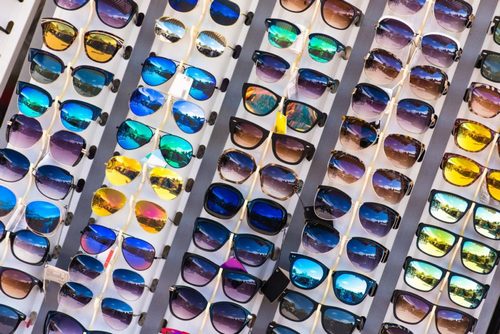Sunglasses should be bought only in trusted stores and optics stores. If you doubt the availability or quality of the UV filter, contact the optics salon – there, on a special device (spectrophotometer), the glasses will check the degree of protection against UV radiation.
Remember: it is better to be completely without glasses than with dark glasses without proper UV protection. In bright sunshine, our pupils reflexively decrease in diameter, limiting the harmful effects of UV radiation on the lens and retina. If you are wearing dark glasses without a UV filter, the pupil will remain wide – so even more harmful radiation will penetrate the eye. If you doubt the quality of the sunglasses, it is better to refrain from buying.
The sun is a natural source of ultraviolet (UV) radiation.
It is of three types:
- UV-C rays are the shortest and potentially the most dangerous. Fortunately, they do not reach the Earth’s surface, but linger in the ozone layer of the atmosphere;
- UV-B rays are partially filtered by the ozone layer. Thanks to them, tan appears on the skin. In high doses, UV-B rays cause sunburn, pigmentation, and wrinkles. They have a strong damaging effect and are actively absorbed by the anterior segment of the eye (cornea and lens);
- UV-A rays have the lowest energy. They are able to penetrate deep inside the eye and affect the retina.

With an excessive exposure to UV radiation, the development of the following eye diseases is associated:
- macular degeneration – a pathology of the central zone of the retina, manifested by a decrease in visual acuity;
- cataract – clouding of the lens;
- pterygium – a change in the conjunctiva in the form of a pterygoid hymen, gradually growing on the cornea;
- pingvekula – a benign neoplasm on the conjunctiva of a yellowish or whitish color;
- oncology – conjunctival cancer of the eyelids, uveal melanoma.
If you think that UV radiation can only lead to long-term consequences, you are mistaken. People resting in the mountains or at sea without sunglasses may almost immediately feel discomfort in their eyes. Usually, after 6-12 hours after being in the bright sun, severe lacrimation, photophobia, complaints of redness of the eyes and a feeling that there is a foreign object in the eyes appear. These are signs of photokeratitis – a corneal burn. It is also called “snow blindness” – this condition leads to a decrease in vision, which can last up to 24–48 hours. If these symptoms occur, you should immediately consult a doctor for diagnosis and treatment.
Does everyone need sunglasses
Both adults and children – regardless of skin pigmentation – are highly likely to damage their eyes due to UV radiation.
However, there are people who are at increased risk of developing diseases associated with UV radiation:
- patients after cataract removal;
- patients with age-related macular degeneration (AMD);
- people with a light color of the iris (blue and green);
- people taking photosensitizing (that is, increasing sensitivity to light) drugs;
- people whose professions and hobbies are associated with a long stay in the air (tourists, athletes), as well as in contact with artificial sources of UV radiation (welders, medical technologists, printing workers, tanning beds);
- Children are especially exposed to the harmful effects of UV radiation – they spend a lot of time in the open sun. In addition, the lenses of children are transparent and cannot protect the retina from UV rays.

It is important to remember: the damage from UV radiation is cumulative, it accumulates throughout life. It is believed that 80% of the dose of UV radiation received over a lifetime is received up to 18 years. UV radiation is not blocked by fog or clouds. The highest amount of UV radiation you risk getting in the middle of the day, at high altitudes and when light is reflected from water or snow.
How to choose sunglasses
The most important criterion for choosing glasses is the reliability of the UV filter. Sunglasses should block 100% of harmful radiation. Prefer lenses marked UV 400 and remember: the color intensity of the lenses does not affect this setting.
The lens material can be any: glass, plastic, polycarbonate, next-generation polyurethane ( NXT ), acrylic. The main thing is that the lens should have high optical properties and not distort color perception.
Sunglasses vary in light transmission. There are five categories of filters. They are indicated by a number from 0 to 4 (usually it is indicated on the inner surface of the lens next to the CE symbol). A filter marked “0” transmits from 80 to 100% of the light, with “4” – from 3 to 8%. In a city, for example, for driving a car, the first or second filter category is enough for a trip to the sea or to the mountains – a third or fourth.

The color of the lenses depends on your preferences and lifestyle. The most comfortable for the eyes are gray, brown or green lenses. The choice of additional coverage depends on the purpose of using sunglasses.
Polarized glasses allow you to feel comfortable even in the brightest light, reliably block sun glare. Such glasses are recommended for driving a car, playing sports in the mountains and beach holidays. The multifunctional coating (hardening, hydrophobic, anti-reflective) significantly prolongs the life of glasses, facilitates the care of them and protects them from scratches.
There are special photochromic lenses. They change their color depending on the external lighting: in the room they are transparent or with a little tint, they darken on the street. Please note: drivers should choose special photochromic lenses – car glass blocks most of the UV radiation, which changes the color of the lenses. If necessary, you can order diopter glasses with blackout and UV protection.
Enjoy the sun and take care of your eyes!



